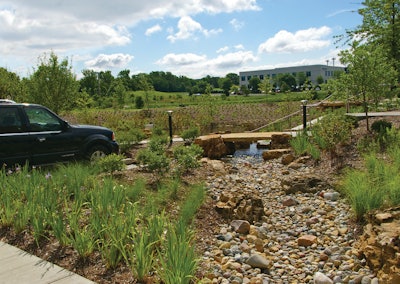
The Sustainable Sites Initiative (SITES), a proposed national rating system for sustainable landscapes, has just wrapped up its two-year pilot project phase. Administrators are now revising the program to better account for regional climatic changes and landscapes that do not contain buildings. The timing is perfect, as recent data suggests that demand for "green" homes and commercial buildings is climbing rapidly.
According to McGraw-Hill Construction, the share of "green" homes in the single-family new construction market has risen from 2% in 2005 to roughly 17%. By 2016 the share is expected to be 29% to 38%. Additionally, a third of home remodelers expect that the majority of their projects will be green by 2016.
Demand for green is also starting to pick up when it comes to landscaping. "Landscape architects have been quite supportive of SITES from the beginning, but now landscape contractors and the general public are also showing a lot of interest," says Danielle Pieranunzi, SITES director and conservation development coordinator at the Lady Bird Johnson Wildflower Center at The University of Texas at Austin. Pieranunzi is a LEED accredited professional for building design and construction (AP BD+C).
Dialing in the sights on SITES
SITES was created in 2006 to promote sustainable land development and management practices. It is a collaboration between the American Society of Landscape Architects (ASLA), the Lady Bird Johnson Wildflower Center, and the United States Botanic Garden. SITES was originally reported by Green Industry PRO magazine when the pilot project phase commenced in 2010. Visit www.greenindustrypros.com/SustainableSites to review that series.
Now that the two-year pilot project phase has drawn to a close, the SITES team is looking to make improvements. "We're not talking about wholesale changes," says Pieranunzi. "The basic structure will stay the same."
Some of the improvements include:
- Expanded set of calculation guidelines, examples and performance benchmarks
- Easier, more streamlined documentation
- Launch of professional credentialing program
- Revised rating system in 2013 based on feedback gathered during the pilot project phase
- Partnership with a third-party certifying body to administer project certification starting with the 2013 rating system
All things considered
In its revisions, SITES is taking steps to ensure that all landscapes are included, including those which do not have buildings. These include parks, arboretums, botanical gardens and streetscapes.
"We also want to stress the difference between urban and rural sites," Pieranunzi points out. "We want to make sure that each has similar opportunities to be certified as sustainable. Finally, we want to ensure that the new rating system covers different regions and climates."
The current rating system is geared toward new construction and major landscape renovation. But ongoing management of the landscape is also very important. "Maintenance is more of a commitment to operate a certain way," Pieranunzi explains. "The maintenance component (of SITES) is a prerequisite; the designer or architect must work with a maintenance contractor to develop the plan. We encourage it to happen very early in the process, even pre-design. You need to show how you're going to deal with invasives and composting, for instance."
SITES has considered creating a specific Operations & Maintenance rating system, though nothing has materialized as of yet. "If it's not a major renovation or new construction," Pieranunzi points out, "it should still be rewarded when sustainable landscape improvements are made."
For now, though, the focus will remain on major renovations and new construction. As of late-April, three pilot projects have been certified. When studying these, in addition to the 150 or so that applied at the beginning of the pilot project phase, some trends have been identified. "We've gotten an idea of what designers and contractors are looking to do," Pieranunzi says. Popular features have included:
- Using native vegetation
- Removing invasives
- Stormwater management (for volume and quality)
- Green roofs
There is also more interest in engaging users in a site. For example, one of the pilot projects, a Novus International corporate campus in Missouri, incorporated a walking trail and vegetable garden to get employees active in the outdoors.




















